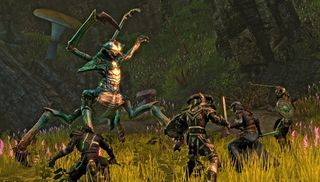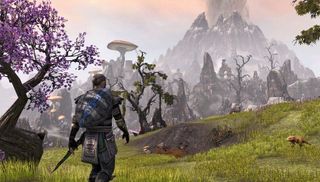The Elder Scrolls Online hands-on: six levels of combat, crafting and exploration

This article was originally published in PC Gamer UK Issue 252.
It starts, as it always does, in prison. But The Elder Scrolls Online's take on the series' traditional opening is a little different. You've been captured and sacrificed to the Daedric prince Molag Bal, harvester of souls. You wake in Coldharbour, Bal's particular plane of Oblivion. Unlike Mehrunes Dagon's Deadlands – which you stormed through again and again in TES IV – Coldharbour is a drab, lifeless reflection of the surface world. Your escape from this place and back to reality constitutes The Elder Scrolls Online's tutorial. My time with the game began immediately after this point.
Where you end up after Coldharbour depends on which of the three factions you belong to. The Aldmeri Dominion, composed of High Elves, Wood Elves, and the catlike Khajiit, are imperious conquerors from the south. The Ebonheart Pact are an alliance of convenience between Skyrim's Nord, Morrowind's Dark Elves and the stealthy Argonians – they're keen to hold on to their independence, but need each other in order to do it. I played the first six levels of the game as a member of the Daggerfall Covenant: the Bretons, Redguard and Orcs who form The Elder Scrolls Online's final faction.
"Those who feared that The Elder Scrolls Online would amount to another cash-in MMO have it wrong."
As such, my character began life in the sea off the coast of Stros M'Kai – an island not seen in the series since the 1998 standalone adventure Redguard. I was rescued by pirates and put to work recruiting specialists for a heist that would secure my new crew passage off the island. So begins the 50-level personal narrative that leads you through Zenimax Online Studios' take on Tamriel, zone by zone. So far, then, so MMO.
Those who feared that The Elder Scrolls Online would amount to another cash-in MMO with a big name behind it have it wrong, but the counter-position – the promise of a casualty-free marriage of emergent RPG and online game – doesn't quite hit the mark either. From my first moment in game it is clear that TESO is the product of a measured and ongoing negotiation between opposing forces: the traditional MMO and the singleplayer game, ambition and technology, the demands of the community and the views of its designers. Its successes and failures alike are produced by that process.

“We're not trying to top Skyrim,” game director Matt Firor says. “If you want to play Skyrim – go play Skyrim! We're doing something a little bit different. It should feel comfortable to people who play Elder Scrolls games, but it's its own game in its own right.”
The first thing that struck me, wandering the streets of the coastal town of Hunding, is how minimal the interface is by MMO standards. Most of the time you'll only be looking at a crosshair, a minimap, and a subtle chat window in the corner of the screen. Status bars and numbered hotkey slots only appear when they're needed, leaving your view of the world uncluttered.
PC Gamer Newsletter
Sign up to get the best content of the week, and great gaming deals, as picked by the editors.
"First-person view also makes it easier to appreciate the above-average degree of interactivity."
There'll be a first-person option, too. While it wasn't present in the build I tried, I was shown the game being played Skyrim-style in a later demonstration. This should come as a relief to players who feared that one of the defining features of the series had been ignored, and I asked Matt Firor why the company had kept its inclusion so quiet.
“We always knew it was something players were going to want. We're still in the process of doing it. In a first-person singleplayer game, all the graphical effects are tuned to be [only so far] in front of me. In a multiplayer game, the same effect has to work far away from the camera when you're looking at it, and from a hundred meters away when another player is looking at you.”
The developers anticipate that players will prefer a zoomed-out view for certain styles of play – particularly the Dark Age of Camelot-style mass PvP – but the option is there, and it works. First-person view also makes it easier to appreciate the above-average degree of interactivity in The Elder Scrolls Online's world.

Books on shelves and tables can be read, and in some cases these lead to quests or earn you experience. Potions and other consumables can be gathered from barrels and chests. It's not as high-fidelity as Skyrim – there are no dynamic physics objects, and the greater majority of items are static and cannot be interacted with – but it works as an MMO adaptation of a traditional Elder Scrolls idea.
"Expect to see a lot more mixing and matching of weapons and magic."
Combat gets a similar treatment. As in the previous games, you press the left mouse button to swing or fire your weapon and hold the right mouse button to block. Power attacks can be charged up and enemy spells can be interrupted with a bash. On top of this is six hotkeyed abilities, an ultimate ability, and a hotkeyed consumable item such as a healing potion. Spells and special moves are cast instantly and have no cooldown: instead of establishing a combat rotation à la World of Warcraft, it's a lot closer to how Skyrim and Oblivion handled favourites menus. Unlike those games, however, spells don't need to be assigned to a hand before they can be cast – so expect to see a lot more mixing and matching of weapons and magic. Success in combat is a case of expending your reserves of health, stamina and magicka to suit the situation. Blocking, dodging and using special melee attacks, for example, all consume a regenerating stamina reserve, making split-second decisions just as important as theorycrafting a great skill build.
“You can't pause the game in an MMO, so what we did was provide you with shortcuts,” lead gameplay designer Nick Konkle says. “That's something that was necessitated by what we do in MMOs, but actually I really enjoy having access to multiple different spells. I like what that does to our game.”
The main weakness of the combat system at the moment is feedback. Ditching the scrolling numbers of a traditional MMO to enhance immersion is praiseworthy, but it needs to be replaced by something and at the moment The Elder Scrolls Online's animations and sound effects don't sell the impact of your blows strongly enough. Remember whittling down an unresponsive dragon with an iron sword in Skyrim? This is one area where the game could do with breaking from the past.
Each zone has a primary narrative to follow with optional objectives branching off from it, and secrets to discover if you decide to push at the boundaries of the map. Moving on from Hunding I fought through my first Dwemer ruin, using a control rod to direct an ancient spider robot as I made my way through a series of environmental traps. Later, I unearthed a chest containing a note that led me across the map, following landmarks to find a buried treasure. As I did this, I was continually recruiting NPCs to my side: a High Elf researcher, a human scoundrel, and a stealthy pirate queen. These encounters ended in decisions about the fates of characters that I'm told will impact the story later on, and this promise was borne out in the composition of the group that I eventually left Stros M'Kai with – and who showed up in the second quest line I played.
Joining in 2011, Chris made his start with PC Gamer turning beautiful trees into magazines, first as a writer and later as deputy editor. Once PCG's reluctant MMO champion , his discovery of Dota 2 in 2012 led him to much darker, stranger places. In 2015, Chris became the editor of PC Gamer Pro, overseeing our online coverage of competitive gaming and esports. He left in 2017, and can be now found making games and recording the Crate & Crowbar podcast.

The Elder Scrolls Online dev says the 'metaverse' is sinking because it ignored 20 years of games doing the exact same thing: 'It's not new, and they should stop treating it like it's new'

The Elder Scrolls Online has made nearly $2 billion in its lifetime, 9 years after the big comeback that doubled its player count overnight
Most Popular


